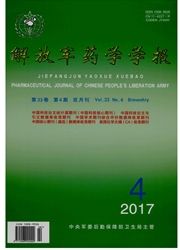

 中文摘要:
中文摘要:
目的观察秦艽不同配伍药对风湿热痹类风湿关节炎模型大鼠足跖肿胀度、关节炎症及血清类风湿因子、G反应蛋白含量的影响。方法将80只SD大鼠随机分为空白组、Ⅱ型胶原组、病证模型组、阳性药组、单味秦艽组、秦艽威灵仙组、秦艽桑寄生组和秦艽防己组共8组,每组10只。采用Ⅱ型胶原诱导加风湿热环境因素刺激制备风湿热痹类风湿关节炎大鼠模型,连续18d。造模结束后各给药组给予制备的对应药液灌胃,空白组、Ⅱ型胶原组、病证模型组给予等量o.9%氯化钠溶液,连续21d。实验中每3d测一次足跖厚度,并计算足跖肿胀度;实验第38天进行关节炎指数评分,酶联免疫法测定各组大鼠血清类风湿因子、C-反应蛋白含量。结果与空白组比较,Ⅱ型胶原组和病证模型组的足跖肿胀度和关节炎指数明显升高(P〈0.01);与病证模型组比较,各给药组足跖肿胀度和关节炎指数均有不同程度的降低,其中秦防组降低最为显著(P〈0.01)。血清学检测结果显示,与空白组比较,Ⅱ型胶原组及病证模型组大鼠血清类风湿因子、G反应蛋白含量明显增加;与病证模型组比较,各给药组大鼠血清类风湿因子、G反应蛋白均有不同程度降低,其中,秦防组类风湿因子、G反应蛋白含量下降尤为明显(P〈0.01)。结论风湿热痹型类风湿关节炎,平寒相配效果优于平温、平平相配,实验结果基本符合中医临床“疗热以寒药”的治疗原则。
 英文摘要:
英文摘要:
Objective To observe the effects of Qinjiao (radix gentianae macrophyllae) in different combinations on the content of paw edema, arthritis, and serum contents of rheumatoid factors and c-reactive protein in wind-damp-heat arthralgia rheumatoid arthritis (RA) model rats. Methods Eighty SPF Sprague-Dawley rats were randomly and equally divided into the blank group, collage Ⅱ model group, wind-damp-heat arthralgia model group, positive drug group, single Qinjiao group, Qinjiao-Weilingxian (Radix et Rhizoma Clematidis ) group, Qinjiao-Sangjisheng (Herba Taxilli ) group, and Qinjiao-Fangji (Radix Stephaniae Tetrandrae ) group.A wind-damp-heat arthralgia model was induced in each group except for the blank group and collage Ⅱ model group by collage Ⅱ and exposed to a wind-damp-heat environ- ment for 18 consecutive days. After modeling, each administration group was gavaged with a corresponding drug solution,while the blank group, collage Ⅱ model group and wind-damp-heat arthralgia model group were given an equivalent of normal saline once daily for 21 consecutive days. The paw thickness was observed once every 3 d, and the severity of swelling was calculated. The arthritis index was scored on the 38th day. The serum levels of rheumatoid factor(RF) and c-reactive protein(CRP) were detected. Results Compared with the blank group, the paw edema and arthritis index in the collage Ⅱ model group and winddamp-heat arthralgia model group significantly increased( P 〈0.01). Compared with the wind-damp-heat arthralgia model group, the paw edema and arthritis index in each treatment group reduced to varying de- grees. Serological test results showed that compared with the blank group, the RF and CRP of serum in the collage Ⅱ model group and wind-damp-heat arthralgia model group significantly increased. Compared with the wind-damp-heat arthralgia model group, the serum levels of RF and CRP significantly decreased to different degrees, especially in the Qin-fang group (P 〈 0.01).C
 同期刊论文项目
同期刊论文项目
 同项目期刊论文
同项目期刊论文
 期刊信息
期刊信息
